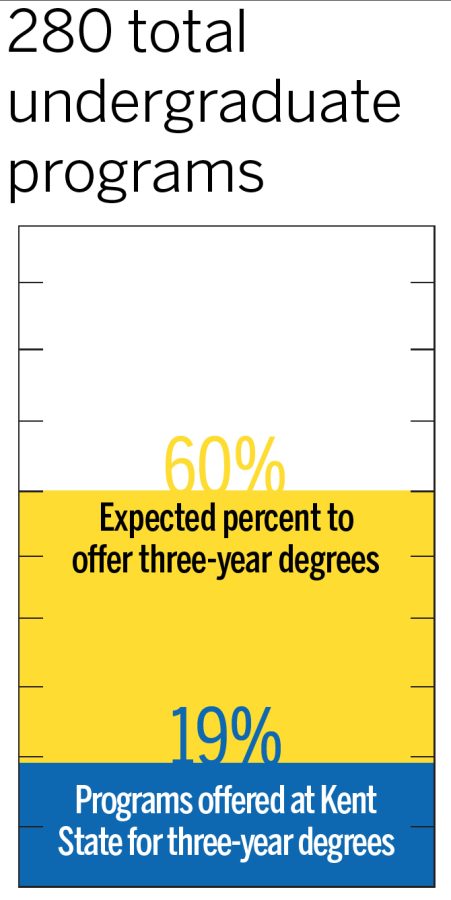The rise of the three-year degree
November 2, 2016
Colleges in Ohio are gearing students to graduate with a four-year undergraduate degree, but in a shorter amount of time — three years.
The Ohio Department of Education (ODE) regulated a law in 2012 requiring universities to transform 60 percent of four-year degree programs into three-year programs by 2014. In order for students to walk out of a university within three years, they would have to enter college with 30 college credits through postsecondary programs such as College Credit Plus and Advanced Placement (AP) courses.
“You can’t get to freshman year of college with zero credits and say, ‘OK, what do I have to do to graduate in three years?’ It’s not that easy,” said Jeff Robinson, ODE director of communications. “For that reason, it’s not for every student. It’s for students (who) are intent on knowing what they want to do, what path they want to follow, how they want to get there and how this can help them lay that out.”
The rise of the three-year degree option developed as a result of tuition rates increasing, along with the rise of average student loan debt of college students and the expectation of students graduating within four years becoming unattainable for many, according to the Ohio Department of Education’s website.
Former Ohio Chancellor of Education Jim Petro put the law into action. Since Petro’s retirement, Kent State only has 54 three-year program options out of all 280 undergraduate degrees available, according to Kent State’s website.
The pros and cons of the 3-year plan weigh differently depending on a student’s situation, Robinson said, but the benefits could include saving tuition money, engaging in the workforce at an earlier point and a variety of study abroad options.
“If you think about the amount of tuition you save and combine that with presumably the amount of salary you will make in that year after you make in the job market when you’re not at school, you can see it could add up to multiple thousands of dollars,” said Todd Diacon, senior vice president of academic affairs and provost. “(The three-year program) was an effort much led by the state legislature in Ohio to make it easier for students to earn a degree in three years.”
The Institute for College Access and Success (TICAS) reported Ohio as the 12th most debt-bearing state in the nation for 2014 college graduates — leaving students an average of $29,353 in debt. TICAS determined a student who graduated from Kent State’s main campus in 2015 took on student debt as much as $33,080 on average.
Diacon said 148 freshmen that entered the Kent Campus in 2013 graduated within three years, which has increased 2.6 percent compared to the freshmen class in 2012.
There are no current plans to add more programs to the three-year degree list, Diacon said.
Caroline Cripe, a senior political science major currently studying in Florence, Italy, completed AP courses in high school and earned 30 college credits when applying to Kent State, which put her two semesters ahead.
“I wanted to finish in three years to save money, essentially,” Cripe wrote in a Facebook message. “I (can) save money and enter the career field sooner (so I’m) still able to leave with an internship and a study abroad experience.”
Even though students like Cripe experience the benefits of graduating within three years, they agree there are downsides, such as an increased amount of work compared to what they would have to do within four years.
In order for a student to earn 120 credit hours and walk out in four years, he or she must obtain 15 credit hours per semester, according to Kent State’s GPS Roadmap. Most of the credits earned while in high school go toward Kent Core classes, such as an English or science credit, instead of fulfilling major credit courses. This leaves some students with a larger workload, taking more than the average amount of credits per semester and even signing up for summer courses.
Without the extra weight, even with 30 credits obtained, a student could fall short of completing studies within the three-year mark.
“I think the main complications come with the rush of trying to complete everything in three years,” Cripe wrote. “My last semester is 19 credits of pretty difficult classes. It all comes with a balance of taking advantage of other aspects of college, such as student organizations, and focusing solely on academics.”
Along with the additional credit hours, Cripe also took summer courses to stay within the three-year roadmap.
Alicia Johnson, a senior communications studies major, said her challenge is taking senior level courses with a junior mindset.
“It wasn’t hard for me to find an internship where I felt experienced enough, but it has been difficult to focus on my internship while I still have other coursework to complete,” Johnson said. “It’s very weird to sit down at a desk and learn about a skill that you are already getting real world experience in at the same time.”
Johnson said it’s tough to know where she stands in her career, whether she is preparing correctly or making the right decisions toward her future, when her peers are reaching milestones that she has surpassed.
“I don’t really have people that are going through the same decisions I am right now, so it’s hard to know if I’m doing everything right, or in the best way,” Johnson said. “Overall, I know that graduating early is the best option for me, but I would be lying if I said it was an easy feat.”
Lydia Taylor is an administration reporter, contact her at [email protected].

















